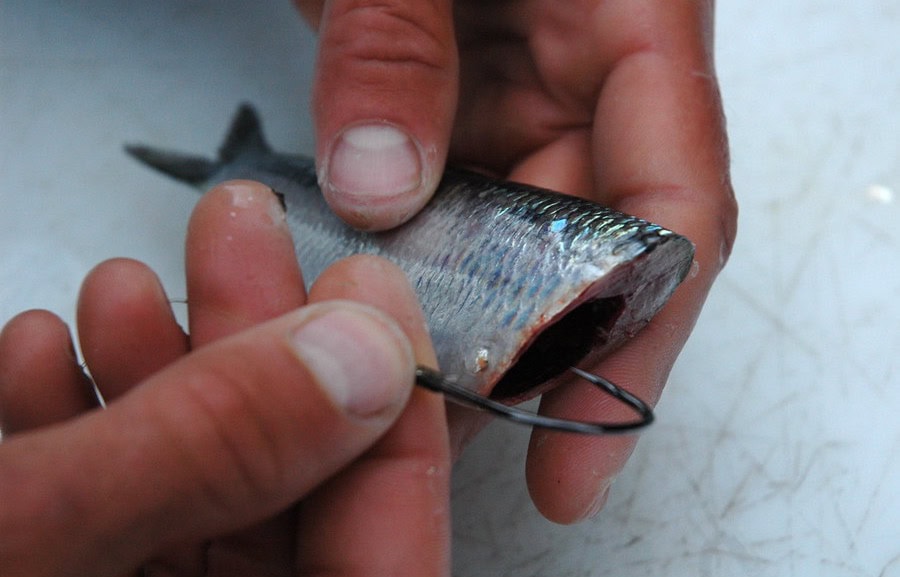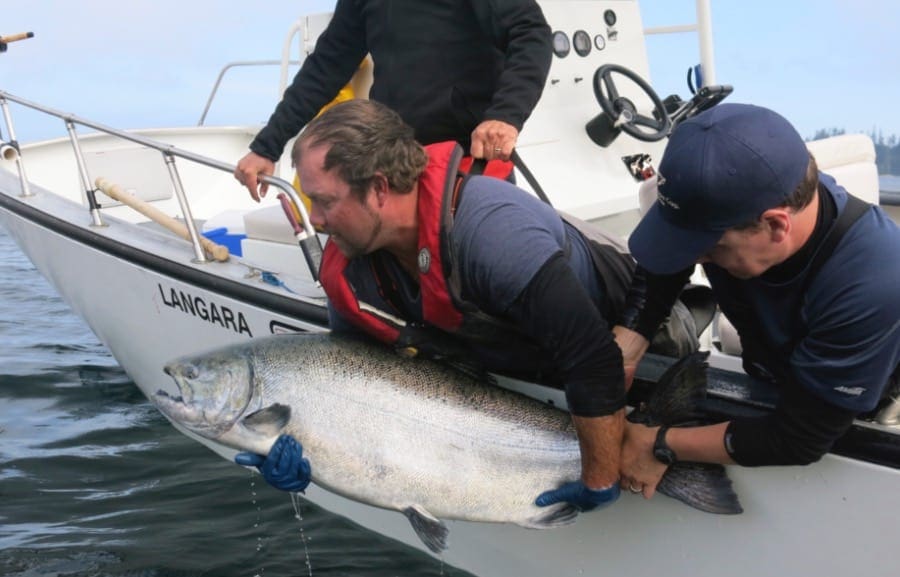16 Jan Cut Plug Herring Salmon Fishing
CUT PLUG HERRING FISHING TIPS
HOW TO SET UP A CUT PLUG HERRING RIG FOR SUCCESS
Cut plug herring fishing is one of the funnest ways to catch salmon. It’s not terribly complicated but there are some things that make for success when fishing a cut plug herring for salmon. In this post you’ll learn all about cut plug herring fishing…
HOW TO RIG A CUT PLUG
HOW TO FISH A HERRING PLUG
BRINE FOR MAKING YOUR PLUGS LAST
SALMON MOOCHING SETUPS
GUIDE TIPS FOR CUT PLUGGING
HOW TO RIG A CUT PLUG
There’s a lot of ways to rig a cut plug, but the most important part is to make sure your herring rolls well even under slow trolling speed. A herring that doesn’t roll won’t get as many bites as one that does. Here in British Columbia we usually fish a double hook leader. This leader rig gives you the ability to have a trailer hook (near the tail) and the tow hook, the one that is at the cut portion of the cut plug. The tow hook is the most important as the tow hook placement really determines if the plug will roll well or not. The cut is also important. A sharp angled cut will make a faster spin, a more blunt cut usually slows the plug down and makes the plug last longer.
- Cut plugs are best rigged on a two hook leader. Leave about 3 inches between the tow & trailer hook.
- The trailer hook is what hooks most of the fish, use a 4/0 octopus hook.
- The tow hook is the hook in the front, its placement is key to a good roll.
- Always check your roll at your trolling speed. A plug that doesn’t roll is no good.
- The cut angle isn’t as important as most people think. The tow hook placement is key.
- Take the guts out, do this carefully as to not break the herring’s belly skin.
- Wet your hands before handling the herring, you don’t want to take off the scales.
- Watch me hook up a herring at 7:57 on our YouTube video.

HOW TO FISH A CUT PLUG HERRING
There are lots of ways to fish a cut plug herring. You can fish it on a downrigger, usually behind a flasher or you can go old school and fish mooching style with a weight. The cut plug herring fishing we do at Langara Island BC is all done by mooching, a very simple and effective way of salmon fishing in shallow inshore environments. Trolling allows you to cover larger areas of water, while mooching focuses on more concentrated areas, very often tide based, waiting for fish to come to a certain area on a portion of a given tide. Salmon on BC’s coast spend time inshore to feed on needlefish, anchovies and herring. A cut plug herring is a like a big juicy steak and when fished in a mooching style is the most effective way to catch bigger shore hugging chinook salmon.
- Trolling a cut plug on a down rigger allows you to cover lots of area and deeper water.
- Mooching a cut plug is the most effective way to catch bigger chinook salmon.
- Knowing what your local tides are doing is very important, this is the basis of all coastal salmon fishing.
- Deeper isn’t always better, a nice flashy cut plug will bring salmon up to feed.
- Scent really isn’t a factor. Cut plugs are a visual stimulant that entice the bite.

BRINING YOUR HERRING
Herring aren’t cheap so you’ll want to make the most out of your purchase of a few packs. The brine I use is one cup of salt to every three packs of herring. The bait coolers we use hold six packs, so two scoops of salt. I’ll add the salt and some water, give it a good stir, then fill the rest of the cooler and then add the frozen herring. If the herring is stuck to the styrofoam sheet just leave it on, it will come loose as it thaws. Often, if you pull the frozen herring off the packaging it will lose scales on that side.
- One cup of salt for every three packs of herring.
- Herring usually take about 12 hours to brine and thaw properly.
- If fishing is hot, you can pre-cut your plugs and then put them back in the brine.
- Keep a small bucket of salt onboard your boat, in case your herring are soft you can add some more.
- If you don’t use all your herring, add some ice to keep them fresh for the next day.
- Freshen up your bait water if it is brown or begins to smell.

SALMON MOOCHING SETUPS
Here’s a rundown of the mooching gear we use for cut plug herring fishing here in British Columbia.
- Shimano Technium Mooching Rod. For the price this is a really good rod, the Medium Heavy is the best. It has lots of backbone and is nice for fishing weights from 4-10 ounces.
- In BC we fish mooching reels, no level winds. The Islander MR3 Mooching Reel is our go to. It has an excellent drag system and takes a beating on the water and always holds up.
- Reels are spooled with Maxima Ultragreen 30 or 25 pound mainline.
- The terminal tackle consists of 8 ounce slip weights, a slider system made up of surgical tubing w/ crib peg and a ball bearing/chain link swivel.
- Invest in some ball bearing swivels, they are invaluable when running cut plug herring, allowing for the best possible roll.

GUIDE TIPS FOR CUT PLUGGING
I’ve been pretty lucky to have spent the last 25 years as a salmon guide on the BC coast. At about 1000 hours a season it adds up and I don’t even want to think how many cut plugs I’ve rigged. Here is a bit of herring wisdom from over the years…
- As a guide, being quick and efficient if everything. Getting bait in the water and keeping it fishing equals greater success. If you’re in a good bite, pre cut some bait and make sure you have a leader board ready to go.
- Always make sure you herring is rolling before you put it down. Can’t stress this one enough, make sure you have a bait that is spinning nice and tightly, even at slow boat speed.
- Your most important baits of the day are the first ones you put down. They’re usually on until you get bite or a fish, so make those look extra good.
- Only change your bait if they’re not rolling. No other reason and often if they’re not rolling you can re-rig the tow hook to get them to roll again.
- Always check your herring after a bite. You may have been stripped or, if the herring is still on the hooks, it likely isn’t rolling well anymore.
- Have fun, know your local fishing regulations and always practice mindful fish handling.
![]()
About the Author
Yos Gladstone is the owner operator of Chromer Sport Fishing, a guiding company and booking agency based in British Columbia, Canada. A full-time salmon & steelhead guide, Yos spends 200+ days a year on the water fishing, guiding and hosting trips.